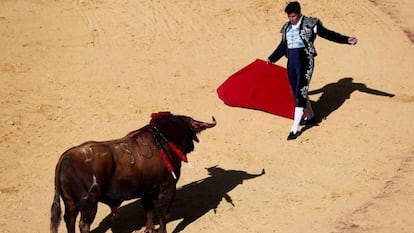The day will come when bullfighting is history
Two centuries have not completely cured the Spanish of the savagery involved in a “fiesta” that involves the slow death of an animal
Two centuries ago, the horses were disemboweled in the middle of the bullfight, and then stitched up in the square to stretch out the rest of their useful lives in front of the bulls that are trying to kill them, and who also going to die. This is the story told by Robert Hughes in his splendid book Goya, which devotes several pages to the fight against bullfighting as part of a modernizing eagerness that the enlightened tried – unsuccessfully – to wage in Spain.

In some aspects, we have evolved. The horses no longer die gutted in the ring. Pro-bullfighting people are outraged by the criticism they receive, but they know – or should know – that throughout history various political figures and movements opposed bullfighting. Carlos III, a king who undeniably brought some good things to Spain, tried to ban the bulls in 1771. Carlos IV did too. In an act of brazen populism, King Joseph I Bonaparte, however, celebrated his coronation with a bullfight. Bread and circus was a formula that worked well for the Romans, and the Enlightenment could not get rid of it.
Pro-bullfighting people are outraged by the criticism they receive, but they should know that various political figures and movements opposed it
Two centuries have not completely cured us of the savagery, backwardness or extravagance that – for some, with an opinion just as respectable as others – comes with enjoying a “fiesta” that guarantees the death of an animal. But at least time has allowed us to advance within its limits.
Other things are happening in Spain besides the independence referendum in Catalonia. One of those things was the release last week of the documentary Tauromaquia, from Jaime Alekos, and presented by PACMA, a Spanish animal rights group. His camera recorded actual images of bullfights from the bull’s point of view, including the animal’s terror, trembling, feces, and all the other symptoms of humiliation the tortured experiences. It only provokes compassion, without the typical epic and brave interpretations of bullfights.
In his documentary Land Without Bread (1933), Spanish filmmaker Luis Buñuel captured how fiancés in Las Hurdes, a mountainous region in western Spain, had to prove their manhood by ripping the heads off of chickens on a rope. If they failed, they would keep trying until they had the skull in their hands. The movie also showed depictions of incest leading to deformities and extreme hunger in the western Extremadura region of Spain.
It may take decades for our grandchildren to be horrified by the Spain of the documentary ‘Tauromaquia’
Spain is progressing little by little in many matters – even when it comes to the abuse of animals. The beheadings of hens and ducks, and the throwing of goats from a bell tower, seem to have been consigned to history. Bullfighting has been banned in some places, although the issue remains in court; and this summer authorities in the Balearic Islands prohibited the death of the animal at the event, as is the case in Portugal. Horses are no longer gutted and sewn back up in town squares.
Progress is gradual. It may take decades for our grandchildren to be horrified by the Spain of the documentary Tauromaquia, just as we are horrified today by the Spain of Goya or Buñuel. But it will come.
English version by Debora Almeida.
Tu suscripción se está usando en otro dispositivo
¿Quieres añadir otro usuario a tu suscripción?
Si continúas leyendo en este dispositivo, no se podrá leer en el otro.
FlechaTu suscripción se está usando en otro dispositivo y solo puedes acceder a EL PAÍS desde un dispositivo a la vez.
Si quieres compartir tu cuenta, cambia tu suscripción a la modalidad Premium, así podrás añadir otro usuario. Cada uno accederá con su propia cuenta de email, lo que os permitirá personalizar vuestra experiencia en EL PAÍS.
¿Tienes una suscripción de empresa? Accede aquí para contratar más cuentas.
En el caso de no saber quién está usando tu cuenta, te recomendamos cambiar tu contraseña aquí.
Si decides continuar compartiendo tu cuenta, este mensaje se mostrará en tu dispositivo y en el de la otra persona que está usando tu cuenta de forma indefinida, afectando a tu experiencia de lectura. Puedes consultar aquí los términos y condiciones de la suscripción digital.










































